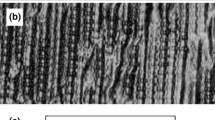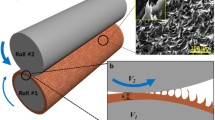Abstract
A polyvinylsilixane sample fabricated to replicate biological attachment systems consisting of microscale pillars (about 230/mm2) approximately 50 μm in diameter, 70 μm in height, and 60 μm center-to-center was characterized for surface roughness, friction force, and contact angle and compared to an unstructured sample. Macroscale coefficient of kinetic friction of the structured sample was found to be almost four times greater than the unstructured sample. This increase was determined to be a result of the structured roughness of the sample and not the random nanoroughness. The structured roughness also increased the hydrophobicity of the structured sample, which is important for self cleaning to occur.





Similar content being viewed by others
References
Adamson AV (1990) Physical chemistry of surfaces. Wiley, New York
Arzt E, Gorb E, Spolenak R (2003) From micro to nano contacts in biological attachment devices. Proc Natl Acad Sci USA 100:10603–10606
Autumn K, Peattie AM (2002) Mechanisms of adhesion in geckos. Integr Comp Biol 42:1081–1090
Autumn K, Liang YA, Hsieh ST, Zesch W, Chan WP, Kenny TW, Fearing R, Full RJ (2000) Adhesive force of a single gecko foot-hair. Nature 405:681–685
Autumn K, Sitti M, Liang YA, Peattie AM, Hansen WR, Sponberg S, Kenny TW, Fearing R, Israelachvili JN, Full RJ (2002) Evidence for van der Waals adhesion in gecko setae. Proc Natl Acad Sci USA 99:12252–12256
Autumn K, Buehler M, Cutkosky M, Fearing R, Full RJ, Goldman D, Groff R, Provancher W, Rizzi AA, Sranli U, Saunders A, Koditschek DE (2005) Robotics in scansorial environments. Proc SPIE 5804:291–302
Barthlott W, Neinhuis C (1997) Purity of the sacred lotus, or escape from contamination in biological surfaces. Planta 202:1–8
Bergmann PJ, Irschick DJ (2005) Effects of temperature on maximum clinging ability in a diurnal gecko: evidence for a passive clinging mechanism? J Exp Zool 303A:785–791
Bhushan B (1984) Influence of test parameters on the measurement of the coefficient of friction of magnetic tapes. Wear 93:81–99
Bhushan B (1996) Tribology and mechanics of magnetic storage devices, 2nd edn. Springer, Berlin Heidelberg New York
Bhushan B (1999) Handbook of micro/nanotribology, 2nd edn. CRC Press, Boca Raton
Bhushan B (2002) Introduction to tribology. Wiley, New York
Bhushan B (2003) Adhesion and stiction: mechanisms, measurement techniques and methods for reduction. J Vac Sci Technol B 21:2262–2296
Bhushan B (2005) Introduction to nanotribology and nanomechanics. Springer, Berlin Heidelberg New York
Bhushan B, Jung YC (2006) Micro- and nanoscale characterization of hydrophobic and hydrophilic leaf surfaces. Nanotechnology 17:2758–2772
Bhushan B, Peressadko AG, Kim TW (2006) Adhesion analysis of two-level hierarchical morphology in natural attachment systems for smart adhesion. J Adhes Sci Technol (in press)
Burton Z, Bhushan B (2005) Hydrophobicity, adhesion, and friction properties of nanopatterned polymers and scale dependence for micro- and nanoelectromechanical systems. Nano Lett 5:1607–1613
Dellit WD (1934) Zur anatomie und physiologie der Geckozehe. Jena Z Naturw 68:613–658
Full RJ, Fearing RS, Kenny TW, Autumn K (2004) Adhesive microstructure and method of forming same, US Patent #6737160
Gao H, Wang X, Yao H, Gorb S, Arzt E (2005) Mechanics of hierarchical adhesion structures of geckos. Mech Mater 37:275–285
Geim AK, Dubonos SV, Grigorieva IV, Novoselov KS, Zhukov AA, Shapoval SY (2003) Microfabricated adhesive mimicking gecko foot-hair. Nat Mater 2:461–463
Gennaro JGJ (1969) The gecko grip. Nat Hist 78:36–43
Glassmaker NJ, Jagota A, Hui CY, Kim J (2004) Design of biomimetic fibrillar interfaces: 1. Making contact. J R Soc Interface 1:23–33
Glassmaker NJ, Jagota A, Hui CY (2005) Adhesion enhancement in a biomimetic fibrillar interface. Acta Biomat 1:367–375
Gorb S (2001) Attachment devices of insect cuticle. Kluwer Academic Press, Dordrecht
Hansen WR, Autumn K (2005) Evidence for self-cleaning in gecko setae. Proc Natl Acad Sci USA 102:385–389
Hiller U (1968) Untersuchungen zum Feinbau und zur Funktion der Haftborsten von Reptilien. Z Morphol Tiere 62:307–362
Hinds WC (1982) Aerosol technology: properties, behavior, and measurement of airborne particles. Wiley, New York
Hora SL (1923) The adhesive apparatus on the toes of certain geckos and tree frogs. J Proc Asiat Soc Beng 9:137–145
Huber G, Gorb SN, Spolenak R, Arzt E (2005a) Resolving the nanoscale adhesion of individual gecko spatulae by atomic force microscopy. Biol Lett 1:2–4
Huber G, Mantz H, Spolenak R, Mecke K, Jacobs K, Gorb SN, Arzt E (2005b) Evidence for capillarity contributions to gecko adhesion from single spatula and nanomechanical measurements. Proc Natl Acad Sci USA 102:16293–16296
Hui CY, Glassmaker NJ, Tang T, Jagota A (2004) “Design of biomimetic fibrillar interfaces: 2. Mechanics of enhanced adhesion.” J R Soc Interface 1:35–48
Irschick DJ, Austin CC, Petren K, Fisher RN, Losos JB, Ellers O (1996) A comparative analysis of clinging ability among pad-bearing lizards. Biol J Linn Soc 59:21–35
Israelachvili JN (1992) Intermolecular and surface forces, 2nd edn. Academic San Diego
Jaenicke R (1998) Atmospheric aerosol size distribution. In: Harrison RM, van Grieken R (eds) Atmospheric particles. Wiley, New York, pp 1–29
Jagota A, Bennison SJ (2002) Mechanics of adhesion through a fibrillar microstructure. Integr Comp Biol 42:1140–1145
Menon C, Murphy M, Sitti M (2004) Gecko inspired surface climbing robots. In: IEEE international conference on robotics biomimetics, August 22–26, pp 431–436
Northen MT, Turner KL (2005) A batch fabricated biomimetic dry adhesive. Nanotechnology 16:1159–1166
Northen MT, Turner KL (2006) Batch fabrication and characterization of nanostructures for enhanced adhesion. Curr Appl Phys 6:379–383
Nosonovsky M, Bhushan B (2005) Roughness optimization for biomimetic superhydrophobic surfaces. Microsyst Technol 11:535–549
Nosonovsky M, Bhushan B (2006) Wetting of rough three-dimensional superhydrophobic surfaces. Microsyst Technol 12:273–281
Peressadko AG (2005) Max Planck Institute for Metals Research, Stuttgart, personal communications
Persson BNJ, Gorb S (2003) The effect of surface roughness on the adhesion of elastic plates with application to biological systems. J Chem Phys 119:11437–11444
Ruibal R, Ernst V (1965) The structure of the digital setae of lizards. J Morph 117:271–294
Russell AP (1975) A contribution to the functional morphology of the foot of the tokay, Gekko gecko. J Zool Lond 176:437–476
Schleich HH, Kästle W (1986) Ultrastrukturen an Gecko-Zehen. Amphibia Reptilia 7:141–166
Schmidt HR (1904) Zur Anatomie und Physiologie der Geckopfote. Jena Z Naturw 39:551
Simmermacher G (1884) Untersuchungen uber haftapparate an tarsalgliedern von insekten. Zeitschr Wiss Zool 40:481–556
Sitti M (2003) High aspect ratio polymer micro/nano-structure manufacturing using nanoembossing, nanomolding and directed self-assembly. In: Proceedings of IEEE/ASME advanced mechatronics conference, vol 2, July 20–24, pp 886–890
Sitti M, Fearing RS (2003) Synthetic gecko foot-hair for micro/nano structures for future wall-climbing robots. In: Proceedings of IEEE international conference on robotics and automation, vol 1, September 14–19, pp 1164–1170
Smith AM, Callow JA (2006) Biological adhesives. Springer, Berlin Heidelberg Germany
Stork NE (1980) Experimental analysis of adhesion of Chrysolina polita on a variety of surfaces. J Exp Biol 88:91–107
Sun W, Neuzil P, Kustandi TS, Oh S, Samper VD (2005) The nature of the gecko lizard adhesive force. Biophys J 89:L14–L17
Wagler J (1830) Naturliches System der Amphibien. J. G. Cotta’schen Buchhandlung, Munich
Wenzel RN (1936) Resistance of solid surfaces to wetting by water. Indust Eng Chem 28:988–994
Williams EE, Peterson JA (1982) Convergent and alternative designs in the digital adhesive pads of scincid lizards. Science 215:1509–1511
Yurdumakan B, Raravikar NR, Ajayan PM, Dhinojwala A (2005) Synthetic gecko foot-hairs from multiwalled carbon nanotubes. Chem Comm 2005:3799–3801
Acknowledgments
The authors thank Dr. Andrei G. Peressadko of the Max Planck Institute for Metals Research, Stuttgart, Germany, for providing the samples. The authors also thank Yong-Chae Jung and Dr. Zhenhua Tao for experimental assistance and helpful discussions. SEM images were obtained by Dr. Manuel Palacio.
Author information
Authors and Affiliations
Corresponding author
Rights and permissions
About this article
Cite this article
Bhushan, B., Sayer, R.A. Surface characterization and friction of a bio-inspired reversible adhesive tape. Microsyst Technol 13, 71–78 (2007). https://doi.org/10.1007/s00542-006-0256-2
Received:
Accepted:
Published:
Issue Date:
DOI: https://doi.org/10.1007/s00542-006-0256-2




